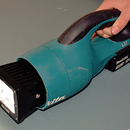Introduction: Battery Cases for Electronic Kits.
If you have built one of the cheap electronic kits featured in my previous instructable, you probably want to put in some sort of case. Having your project in a nice looking case will really make your project look great and will impress your friends much more than a naked PCB with wires and a battery hanging off it. Your project should be something you can be proud of, take to a job interview and say look what I made!
This instructable will show you what's possible with a little thought and a laser cutter.
There are five types of cases shown here,
- Case without a battery or switch: The easiest to make but you will need to run a lead to your power supply.
- Case with a battery: Great if your kit has a switch.
- Case with a battery and rocker switch: The most challenging to build, but some kits don't have a switch.
- Case with a push button, battery and switch.
- Case with a slide switch, a little easier to assemble than the rocker switch version.
Also, some of the eBay kits have different versions, the PCB which means the case wont fit. I'm in the process of designing cases for the different versions.
Step 1: Tools and Supplies
You will need a few bits and pieces to build these cases, but once you have everything, they are very cheap to make.
- Laser Cutter
- CAD drawing program
- 3mm acrylic sheet.
- Selection of 3mm screws and nuts
- Selection of 3mm standoffs
- Super Glue
- 3mm flat washers
- Solder and soldering iron
- Digital Caliper
- Button cell batteries (CR2032)
Step 2: Flip Flop Case, No Battery
The flip-flop circuit is the easiest to make a case for, as the PCB has four mounting holes. Shown are 2 types of case one with a battery and switch and one without.
The case without the switch and battery holder has the advantage of being very easy to make, but you still have the problem of powering the device and switching it off and on.
The student project shown, solved this by fitting a button cell on lead with a header plug that can be disconnected.
There are lots of photos with notes to help you assemble your project.
Attachments
Step 3: Flip Flop Case With Battery and Switch
The case with a switch and battery is a bit more challenging, but it makes for a much better display than having wires and stuff hanging out the side.
The switched case can be turned off and on by pushing the button/lever on the side of the case and is the basis for the design of the other cases shown here.
Attachments
Step 4: Flip Flop 2 Case
(Images to come)
I found that the flip flop in the previous step is now getting hard to find, this is the case for the more common large PCB flip flop. I also found that some students struggled with the four washers holding the PCB down so there is a DXF for a one-piece washer that needs to be cut from very thin material. I found the clear covers from ring binder suppliers works well.
Also there is a new version of the case with a slide switch which is much easier to assemble than the rocker switch version
Step 5: Dice Case
The dice case has 2 button cells a switch and a push button on the top. The kit itself looks great but doesn't really work very well, It possible to throw a zero, and it has some weird combinations of LEDs
The PCB is held down with washes on each corner as the PCB has no mounting holes, so you will have to cut the component leads very short to get everything to fit correctly.
Attachments
Step 6: Sound Flasher
The assembly process for the sound flasher is almost identical to the dice and flip-flop with a battery.The case is the same design just smaller, only has one battery and it has no push button on the top. There is not as much detail in the photos as the flip-flop or dice, so if you get stuck, just look back at those projects.
Make sure the component leads on the back of the PCB are cut very short, to give you space for the wires.
It's a great little project and will flash when there is a sound.
Step 7: Door Bell Case
This case has two button cells and no switch. It is very easy to put together, but you need to make sure that the pigtails on the back of the PCB are cut off very short, and the wires to the battery are also short as possible.
After going to all the effort of making this case I found that the battery will run down after 2 weeks just sitting on the shelf, doing nothing...Damn it! Really needs a switch to turn it off.
Step 8: Lucky Wheel Case
The Lucky wheel case has 2 button cells an on-off switch and a button to make the lights spin. A little more challenging to put together, and you will have to super glue a wire to the rocker switch
Attachments
Step 9: Chaser
Ok If you got this far you will have a good idea on how to put the cases together. The last three kits are very similar to what has already been shown, so you shouldn't have any difficulty assembling them, so I haven't put as much detail in the assembly photos.
The chaser is almost identical to the dice, so if you get stuck, you can go back and have a look at that.
Also, there are at least 3 versions of the PCB so measure the PCB and choose the correct file for laser cutting
Step 10: FM Transmitter
The FM Transmitter is one of the easiest cases to make as the kit already has a battery holder and switch.
With only 3 pieces some screws, standoffs and some washers you should have no problems assembling this case.
Attachments
Step 11: LED Hour Glass Case
The LED Hour Glass Case is also very easy to put together, as it only requires two batteries and no switch. If you want to run the hourglass for more than a few minutes I would suggest that you use either bigger batteries or a power supply, as the little button cells will run flat very quickly.
Attachments

Participated in the
Pocket-Sized Contest

Participated in the
Pro Tips Challenge














